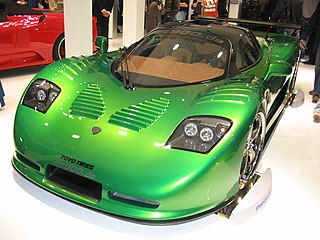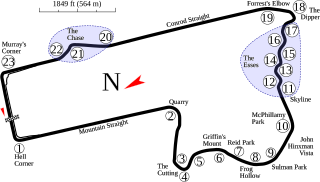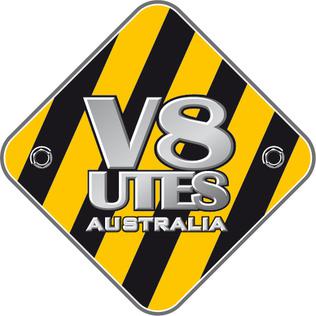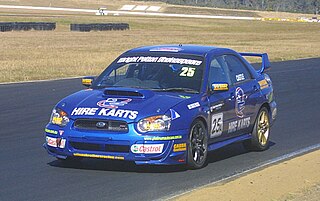Related Research Articles

The Mosler MT900 is a high performance sports car built by now-defunct American automotive manufacturer Mosler Automotive.

Jim Richards is a New Zealand racing driver who won numerous championships in his home country and in Australia. While now retired from professional racing, Richards continues to compete in the Touring Car Masters series.

The Sandown 500 is an annual endurance motor race which is staged at the Sandown Raceway, near Melbourne, Victoria, Australia from 1964. The event's name, distance – and the category of cars competing in it – has varied widely throughout its history. Currently, the event is held as a championship event for Supercars.

The Australian Nations Cup Championship was a motor racing title sanctioned by the Confederation of Australian Motor Sport (CAMS) from 2000 to 2004.

The 2002 Bathurst 24 Hour was an endurance motor race staged at the Mount Panorama Circuit just outside Bathurst in New South Wales, Australia. The race, which was the first 24-hour event to be held at Mount Panorama, started at 4:00pm on 16 November and finished at 4:00pm on 17 November. It was the first 24 Hour race to be held in Australia since the 1954 Mount Druitt 24 Hours Road Race.

The 2003 Bathurst 24 Hour was a motor race staged at the Mount Panorama Circuit just outside Bathurst in New South Wales, Australia. The race started at 2:00pm on 22 November 2003 and finished at 2:00pm on 23 November. It was the second Bathurst 24 Hour.

The Bathurst 12 Hour, currently known as the Repco Bathurst 12 Hour for sponsorship reasons, is an annual endurance race for GT and production cars held at the Mount Panorama Circuit, in Bathurst, Australia. The race was first held in 1991 for Series Production cars and moved to Sydney's Eastern Creek Raceway in 1995 before being discontinued. The race was revived in 2007, again for production cars, before adding a new class for GT3 and other GT cars in 2011. This has led to unprecedented domestic and international exposure for the event. In all, twenty one races have taken place; twenty at Mount Panorama and one at Eastern Creek Raceway.

The V8 Ute Racing Series, known originally as the V8 BRute Utes was an Australian motor racing series for utilities, derived from the Australian Production Car Championship. It was conceived in 2000 by PROCAR chief and owner Ross Palmer, V8 Ute Patron Ian McAlister and Procar employee Craig Denyer and launched March 2001, as V8 Brute Utes, at the Clipsal 500 in Adelaide. The series was instantly popular, in part because of aggressive driving style of competitors, a style encouraged by the use of reverse grid racing, but also because of its very fan friendly marketing which included gimmicks like referring to each of its drivers by a nickname.

The 2000 Supercheap Auto GT Production Car 3 Hour Showroom Showdown was an endurance race for GT Production Cars The event was staged at the Mount Panorama Circuit, Bathurst, New South Wales, Australia on Saturday 19 November 2000 as a support event on program for the 2000 FAI 1000.

The Australian GT Championship is a CAMS-sanctioned national title for drivers of GT cars, held annually from 1960 to 1963, from 1982 to 1985 and from 2005. Each championship up to and including the 1963 title was contested over a single race and those after that year over a series of races. The categories which have contested the championship have not always been well defined and often have become a home for cars orphaned by category collapse or a sudden change in regulation.

John Donald McIntyre is a New Zealand racecar driver who competes in the V8SuperTourer championship and is a co-driver for Ford Performance Racing in the V8 Supercar Series at Sandown and Bathurst.

The Bathurst 24 Hour was an endurance race for GT and production cars held at the Mount Panorama Circuit in Bathurst, New South Wales in 2002 and 2003. Only two races were held before the collapse of the management organisation PROCAR. Both races were won by V8 Supercar team Garry Rogers Motorsport with Holden Monaros.

Group 3E Series Production Cars is an Australian motor racing formula for production based cars competing with limited modifications. Group 3E cars formerly contested the Australian Manufacturers' Championship and Australian Production Car Championship titles and compete in the annual Bathurst 12 Hour and Bathurst 6 Hour endurance races.

Warren Raymond Luff, is best known as a race driver, stunt driver and driver training instructor. He is the son of well-known driver training instructor Ian Luff. He currently co-drives for Team 18 in the Repco Supercars Championship with Scott Pye in the No. 20 Chevrolet Camaro ZL1.

David Wall is an Australian racing driver competing in the Porsche Carrera Cup Australia Championship. He currently drives the No. 38 Porsche 911 GT3 Cup for Wall Racing.

The 2012 Armor All Bathurst 12 Hour was an endurance race for GT3 cars, GT4 cars, Group 3E Series Production Cars and Dubai 24 Hour cars. The event, which was staged at the Mount Panorama Circuit, near Bathurst, in New South Wales, Australia on 26 February 2012, was the tenth running of the Bathurst 12 Hour, and the sixth since the race was revived in 2007.

Nathan Pretty is an Australian racecar driver.

Jonathan Robert Lester is a racing driver from New Zealand, competing in various GT3 and touring car championships throughout the Asia-Pacific region.

Group GT3, known technically as Cup Grand Touring Cars and commonly referred to as simply GT3, is a set of regulations maintained by the Fédération Internationale de l'Automobile (FIA) for grand tourer racing cars designed for use in various auto racing series throughout the world. The GT3 category was initially created in 2005 by the SRO Motorsports Group as a third rung in the ladder of grand touring motorsport, below the Group GT1 and Group GT2 categories which were utilized in the SRO's FIA GT Championship, and launched its own series in 2006 called the FIA GT3 European Championship. Since then, Group GT3 has expanded to become the de facto category for many national and international grand touring series, although some series modify the ruleset from the FIA standard. By 2013, nearly 20 automobile manufacturers have built or been represented with GT3 machines.

The Holden Monaro 427C was an Australian built and designed GT style race car based on the Holden Monaro CV8 road car. The car ran in the Procar Australia-run Australian Nations Cup Championship and at the short-lived Bathurst 24 Hour race at the famous Mount Panorama Circuit in Bathurst.
References
- ↑ Peter McKay, Crunch time for the series that add spice, www.smh.com.au Retrieved on 15 April 2015
- 1 2 PROCAR Australia ceases operations Retrieved from www.motorsport.com on 14 December 2009